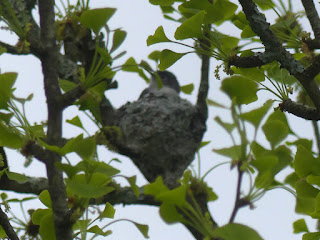Nesting Blue-gray Gnatcatcher
It's surprising sometimes how much time you can spend getting a fairly mediocre picture. I 1st noticed this Blue-gray Gnatcatcher - or its mate - while helping out at a Duke Farms program for schoolkids, though I believe this picture was taken a couple days later when I had more time to loiter around waiting for a photo opportunity. I didn't see 2 birds around at the same time, though:
- Branches and foliage provided only quick looks as the bird(s) returned to the nest.
- These are pretty small birds.
- They're only slightly sexually dimorphic, so distinguishing a male from a female is pretty hard.
- I'm unsure if I was seeing 1 or 2 birds.
The weather in early May was frequently cool in the mornings but was frequently warm in the afternoons. I'm not sure the eggs need someone tending them continuously during this weather. I didn't hear little birds begging for food, and it looked like the nest was complete, so my best guess is that the adult would look for something to eat before hurrying back to the nest. (My backup theory is that there weren't eggs in the nest yet, and the bird(s) were still renovating the inside of the nest.)
Somewhat disappointingly, gnats are not an especially big part of the Blue-gray Gnatcatcher's diet [1], probably because even for a pretty small bird they're a pretty tiny meal. Moths and their caterpillars seem to be favorite foods, though other small insects and spiders are also on the menu. If they catch something big enough to be troublesome, they have a brutally effective solution: They beat the bug to death on the side of a tree.
Despite their small size, they're sometimes victims of Brown-headed Cowbirds, and they have a somewhat novel way of trying to thwart the cowbirds. The gnatcatchers will build multiple nests in the hope that the cowbirds will waste an egg in a nest they weren't going to use anyway.
Although in some areas of the continent it can be pretty tricky to tell which species of gnatcatcher you're seeing, here in the northeast the Blue-gray Gnatcatcher is the only one that should be even close to here.
 |
| May 3, 2023 at Duke Farms Photo 278557538, (c) jpviolette, some rights reserved (CC BY-NC) |
[1] I can attest to the fact that there are gnats in this area in need of being eaten.



Comments
Post a Comment